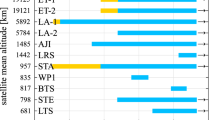Abstract
In the first decade of the twenty first century, great strides have been made in observing the Earth’s gravity field by space-borne techniques such as high-low Satellite-to-Satellite tracking by the Global Positioning System (hl-SST, providing 3D information about orbit perturbations), low-low Satellite-to-Satellite tracking (ll-SST) and Satellite Gravity Gradiometry (SGG). In addition, great advances have been made in (preparations for) gravity field recovery for other bodies in the solar system as well, including Mars and the Moon, using tracking from the Deep Space Network (DSN), but also techniques such as hl-SST, ll-SST, Satellite Laser Ranging (SLR) and Delta VLBI.The purpose of the work described in this paper is to gain insight in the possibilities of observing the gravity field of various planetary bodies by space-borne observation techniques. For low-earth orbiting (LEO) satellites, efficient error propagation tools are available that allow an assessment of the gravity field performance as a function of orbital geometry and instrument or observation technique. These tools have been extended for use to other bodies in our solar system, including the Earth’s Moon, Jupiter, Mars, Titan, Enceladus, Europa and Phobos, which are in the scientific spotlight for various reasons. The gravity field performance has been assessed for satellites orbiting these bodies assuming these satellites can make use of DSN tracking or can acquire ll-SST or SGG observations.
Access this chapter
Tax calculation will be finalised at checkout
Purchases are for personal use only
Similar content being viewed by others
References
Anderson JD, Schubert G, Jacobson RA et al (1998) Europa’s differentiated internal structure: inferences from four galileo encounters. Science 281:2019–2022
Bills BG, Lemoine FG (1995) Gravitational and topographic isotropy of the earth, moon, mars, and venus. J Geophys Res 100(E12):26275. doi:10.1029/95JE02982
Boyce JM (2008) The smithsonian book of mars Konecky & Konecky, Old Saybrook, CT, p 107. ISBN 1-56852-714-4
Colombo OL (1984) The global mapping of gravity with two satellites. vol 7, no. 3. Netherlands Geodetic Commission, Publications on Geodesy, New Series
Drinkwater M, Haagmans R, Muzzi D et al (2007) The GOCE gravity mission: ESA’s first core explorer. In: 3rd GOCE user workshop, 6–8 November 2006, Frascati, pp 1–7. ESA SP-627
ESA (1999) Gravity field and steady-state ocean circulation mission Reports for mission selection, The four candidate earth explorer core missions, SP-1233(1). European Space Agency (July 1999)
Flokstra J, Cupurus R, Wiegerink RJ, van Essen MC (2009) A MEMS-based gravity gradiometer for future planetary missions. Cryogenics 49(11):665–668. ISSN 0011-2275
Guillot T, Stevenson DJ, Hubbard WB, Saumon D (2004) Chapter 3: The interior of jupiter. In: Bagenal F, Dowling TE, McKinnon WB (eds) Jupiter: the planet, satellites and magnetosphere. Cambridge University Press, Cambridge. ISBN 0-521-81808-7
Iess L, Rappaport NJ, Jacobson RA et al (2010) Gravity field, shape, and moment of inertia of titan. Science 327:1367–1369
Matsumoto K, Goossens S, Ishihara Y et al (2010) An improved lunar gravity field model from SELENE and historical tracking data: Revealing the farside gravity features. J Geophys Res 115(E06007):1–20. doi:10.1029/2009JE003499
Mazarico E, Rowlands DD, Neumann GA et al (2012) Orbit determination of the lunar reconnaissance orbiter. J Geod 86:193–207. doi:10.1007/s00190-011-0509-4
MIT (2012) GRAIL Gravity recovery and interior laboratory. http://moon.mit.edu/overview.html. Last accessed 23 Nov 2012
NASA (2012a) GRAIL gravity recovery and interior laboratory. http://www.nasa.gov/mission_pages/grail/main/. Last accessed 8 Oct 2012
NASA (2012b) Lunar and planetary science. http://nssdc.gsfc.nasa.gov/planetary. Last accessed 25 Oct 2012
Pail R, Bruinsma S, Migliaccio F et al (2011) First GOCE gravity field models derived by three different approaches. J Geod 85:819–843. doi: 10.1007/s00190–011–0467–x)
Porco CC, Helfenstein P, Thomas PC et al (2006) Cassini observes the active south pole of enceladus. Science 311:1393–1401. doi:10.1126/science.1123013
Rappaport NJ, Iess L, Wahr J et al (2008) Can cassini detect a subsurface ocean in titan from gravity measurements? Icarus 194:711–720
Reigber Ch, Schwintzer P, Lühr H (1999) The CHAMP geopotential mission. In: Marson I, Sünkel H (ed) Bollettino di Geofisica Teorica e Applicata, vol 40, no. 3–4. pp. 285–289. Istituto Nazionale di Oceanografia e di Geofisica Sperimentale - OHS, Trieste, Italy. ISSN 0006-6729
Rosborough GW (1987) Radial, transverse, and normal satellite position perturbations due to the geopotential. Celest Mech 40:409–421
Rosenblatt P, Rivoldini A, Rambaux N, Dehant V (2011) Mass distribution inside Phobos: a key observational constraint for the origin of Phobos. In: EPSC Abstracts, vol 6, EPSC-DPS2011-761, EPSC-DPS Joint Meeting 2011
Schrama EJO (1991) Gravity field error analysis: Applications of global positioning system receivers and gradiometers on low orbiting platforms. J Geophys Res 96(B12):20041–20051
Smith DE, Zuber MT, Sun X et al (2006) Two-way laser link over interplanetary distance. Science 311(53). doi: 10.1126/science.1120091
Smith DE, Zuber MT, Torrence MH et al (2009) Time variations of Mars’ gravitational field and seasonal changes in the masses of the polar ice caps. J Geophys Res 114( E05002):1–15 doi:10.1029/2008JE003267
Tapley BD, Reigber Ch (1999) GRACE: A satellite-to-satellite tracking geopotential mapping mission. In: Marson I, Sünkel H (eds) Bollettino di Geofisica Teorica e Applicata, vol 40, no 3–4, p 291. Istituto Nazionale di Oceanografia e di Geofisica Sperimentale - OHS, Trieste, Italy. ISSN 0006-6729
Visser PNAM (2005) Low-low satellite-to-satellite tracking: Applicability of analytical linear orbit perturbation theory. J Geod 79(1–3):160–166
Author information
Authors and Affiliations
Corresponding author
Editor information
Editors and Affiliations
Rights and permissions
Copyright information
© 2014 Springer International Publishing Switzerland
About this paper
Cite this paper
Visser, P.N.A.M. (2014). Observing the Gravity Field of Different Planets and Moons by Space-Borne Techniques: Predictions by Fast Error Propagation Tools. In: Marti, U. (eds) Gravity, Geoid and Height Systems. International Association of Geodesy Symposia, vol 141. Springer, Cham. https://doi.org/10.1007/978-3-319-10837-7_41
Download citation
DOI: https://doi.org/10.1007/978-3-319-10837-7_41
Publisher Name: Springer, Cham
Print ISBN: 978-3-319-10836-0
Online ISBN: 978-3-319-10837-7
eBook Packages: Earth and Environmental ScienceEarth and Environmental Science (R0)




